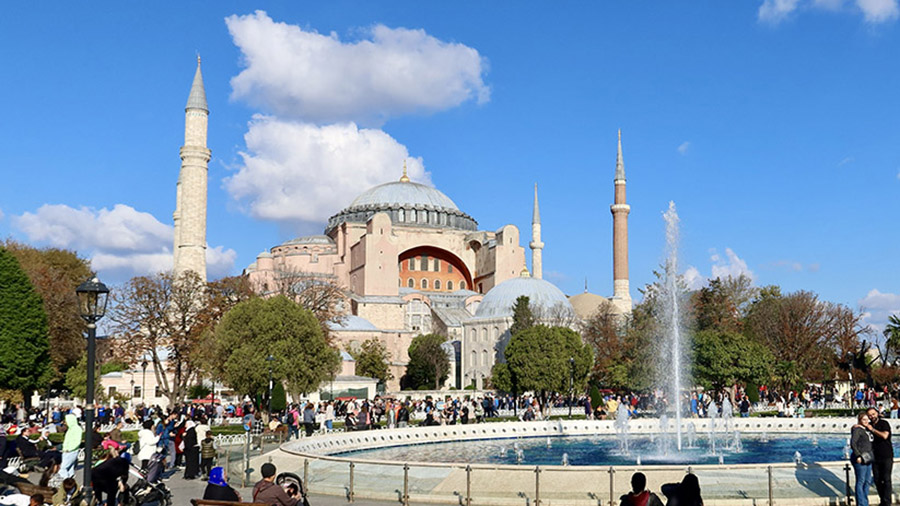
Hagia Sophia rises over Istanbul as it has for the last 1,500 years. Built as a church, it was converted into a mosque, then into a museum and, most recently, back into a mosque.
Ambling through Istanbul, travelers rub elbows with everything from chic rooftop bars to historic bazaars
Story and photography by Shilo Urban
The fattest, healthiest stray dog I’ve ever seen sleeps on the sidewalk before me, snoring softly as hundreds of tourists swirl around us. He doesn’t notice the aroma from the roasted corn cart or the babbling of children in line for scoops of stretchy, chewy Turkish ice cream. Jets of water from turquoise fountains shoot into the air beside us, emulating the minarets all around. Red and white flowers spill from their gardens. Picnickers lounge in the shade on a grassy green, speaking a dozen languages. And still the dog sleeps, smack in the middle of Istanbul, Türkiye — an enigmatic metropolis that straddles Europe and Asia with an ancient-meets-modern flair unlike anywhere else, where chic rooftop bars rub elbows with historic bazaars, five-star hotels with centuries-old palaces.
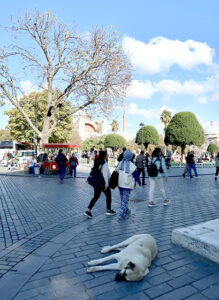
Travelers shouldn’t sleep on Istanbul, where ancient meets modern and chic rooftop bars rub elbows with historic bazaars, five-star hotels with centuries-old palaces.
I’m at the heart, Hagia Sophia, its massive dome rising over the city as it has for the last 1,500 years. Many have come before me: Roman emperors, medieval knights on Crusade, Ottoman sultans and Viking warriors (some of whom left graffiti inside). Today, travelers from around the world gather at the park below. I let the sleeping dog lie and saunter up to the entrance, but the queue is immense — I’ve arrived the same time as the cruise ships. Hagia Sophia (pronounced HAI-uh soh-FEE-uh) was first built as a church, converted into a mosque, and then made into a museum. I visited a decade ago and was gobsmacked by the monumental beauty inside. I’ve never been so wowed by a building.
Then in 2020, Türkiye’s controversial President Erdoğan turned Hagia Sophia back into a mosque. Non-Muslims are still welcome, but they have a separate entrance and must avoid prayer times. I’d felt such soul-lifting wonder on my previous visit that I questioned whether I should even return. Would Hagia Sophia lose some of its magic? Should I just keep my memory as it was?
Either way, I wasn’t spending my morning waiting in line — Istanbul has layers of treasures to explore. Founded by Ancient Greeks, the city sits on a peninsula surrounded by the waters of the Bosphorus strait and an inlet called the Golden Horn. It became the new capital of Rome under Constantine the Great, who also made Christianity the main religion of his empire. Renamed Constantinople, it became the largest, richest, most powerful city on the planet for seven centuries.
Across from Hagia Sophia is another iconic attraction built the same year (532 A.D.): Basilica Cistern, a subterranean reservoir with a capacity of 32 Olympic-size swimming pools. I slink down a staircase into the dark underground chasm. Drip, drip, drip. Hundreds of ornate Corinthian columns hold up towering brick arches overhead, and ghostly carp swim in the few feet of water below. Silver coins glisten on the bottom. Many columns were upcycled from pagan temples and some bear elaborate carvings, including a snake-covered Medusa head with a blank stare and a slight smile at her fate in the shadowy murk.
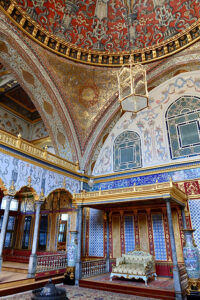
The spectacular Topkapi Palace was the royal residence for the Turkish sultan, hundreds of concubines and his entourage (4,000 people in all).
Constantinople’s fate — and the world’s — was forever altered in 1453 when Muslim Ottomans conquered the city and renamed it Istanbul. The overthrow disrupted the spice trade between Europe and India, introducing the Age of Exploration as adventurers like Christopher Columbus searched for new routes to the East.
Back in their new capital city, the Ottomans began constructing the spectacular Topkapi Palace. Sprawling along a vast chunk of prime coastal real estate, it was the royal residence for the Turkish sultan, hundreds of concubines and his entourage (4,000 people in all).
I enter the walled palace through an enormous gate, stepping into a lush, leafy green courtyard. Countless crimson roses line every path. It’s just the first of four courtyards, each more lavish than the next, with pavilions and chambers that take opulence to a new level. The harem quarters alone have 400 rooms. I wander through a sumptuous realm of gilded fountains and kaleidoscopic stained glass. Canopied divans beckon with plush velvet cushions. But above all are the tiles. Tiles upon tiles upon tiles, each meticulously decorated. Twirling leaves and blooming flowers go on and on, room after room. Bright blues and brilliant reds pop from their shiny surfaces. Greens seem to glow. Electric aquamarine evokes the source of our word turquoise — the Turks.
Overwhelmed by the grandeur, I decompress in the workaday space of the palace kitchens. There are ten domed buildings, including one kitchen solely for pickles and confections. My breath caught, I’m ready to venture inside the Imperial Treasury. Rubies and diamonds dance before my eyes. Enormous emeralds abound. Globular gemstones slather the surface of every gold-encrusted helmet, dagger and drinking vessel.
Stumbling out of Topkapi and onto the sun-splashed cobblestones, I seek a shady spot for a glass of wine and perhaps a blank white wall to stare at. Like a mirage, Sophia Garden Café appears. I climb a short staircase to a quiet, peaceful patio that hovers over the hubbub below. I have a front-row view of Hagia Sophia — and another well-fed dog sleeping against its wall. Chatting with the waiter, he tells me stray animals are well taken care of in Turkey. Residents provide food and water, while cities handle spaying, neutering and medical care. My heart smiles as I lunch on a stack of grilled balsamic vegetables dolloped with fresh yogurt.
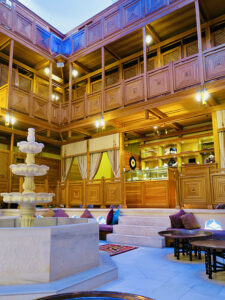
The luxurious Hürrem Sultan Hamman bathhouse and spa, built at the peak of the Ottoman Empire in 1556, remains a spa today.
It’s the perfect light meal to precede an afternoon at the Hürrem Sultan Hamman, a luxurious Turkish bathhouse and spa. It was built at the peak of the Ottoman Empire in 1556 under its greatest sultan, Suleiman the Magnificent, who shocked his subjects with his monogamous marriage to a slave girl from his harem. As the new sultana, or empress, she became one of the most powerful women of all time. Her name was Hürrem Sultan — and this hammam was her personal bathhouse.
My treatment begins at a marble basin, where a bath attendant rinses me with warm water from a gold-plated bowl. Taking my hand, she leads me to a heated marble platform. She scrubs me with a Turkish bath mitt before mounding several feet of bubbles on top of me. My newly exfoliated skin tingles as the bubbles pop in tiny bursts of effervescence. After a massage, I relax by the indoor fountain and am handed fresh pomegranate juice flavored with cinnamon and honey. I’ve never felt so pampered.
I glide the few blocks back to my boutique hotel in the Sultanahmet neighborhood, the core of Istanbul’s historic center. Like the hammam, Hotel Sultania is an architectural ode to royal women. Every room is named after a sultana and decorated to please the same, with fancy tufted headboards and fringed pillows. I settle back onto a velvet bolster in my window nook and nibble the Turkish delight candy laid out for me. Sweet tooth ignited, I head to Olive Anatolian Restaurant on the rooftop for a decadent dinner of dried figs stuffed with spiced walnuts, Turkish kaymak cheese, and thick pistachio cream. Champagne? Please.
I wake up early with a new mission: shopping. And there’s only one place to start — the Grand Bazaar, a dizzying maze of more than 4,000 shops on 61 streets. More than 600 years old, it’s usually swimming in sparkles, shimmers and shoppers like me. But the market has just opened, and its aisles are practically empty. Shopkeepers are still setting up, gossiping with friends and sipping hot tea. Black tea is ubiquitous in Turkey, served all day and night. But it’s Turkish coffee I’m craving, and I find it at Sark Kahvesi café. Turkish coffee is strong and unfiltered, with the grounds slowly falling to the bottom of the cup. Abuzz with caffeine and enamored of the charming café, I ask if I could buy the tablecloth where I’m sitting — my first purchase of the day.
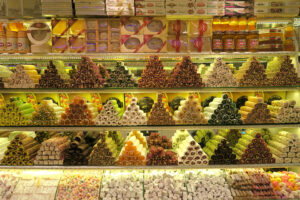
The Grand Bazaar, with more than 4,000 shops on 61 streets, has shops that sell everything from Turkish antiques to cheap souvenirs, trendy soccer jerseys, timeless works of art, candies and baklava — or just a cup of Turkish coffee.
New tablecloth in tow, I lose myself in a warren-like whirl of woven carpets, silver bracelets, leather satchels, pointed slippers and tea sets in every color of the rainbow. Hundreds of glowing mosaic lamps hang beside hand-painted hookahs and burnished copper bowls. You can buy authentic Turkish antiques and cheap souvenir tchotchkes, trendy soccer jerseys and timeless works of art. Sweet shops stack candies from corner to corner and boxes of baklava cover entire walls.
Pistachio-studded nougat or jellied coconut cubes? Toasted walnut rolls or rose petal Turkish delight? Exotic aromas mingle with the sounds of selling and buying. Haggling over prices is expected—it’s awkward at first — but soon I catch the hang of it and start having fun. I leave hours later with a stash of pink peppercorns, a painted copper jar, and three patterned pillow shams made from former prayer rugs.
That night, I’m back at Hagia Sophia. So are the sleeping dogs. Twilight has fallen and the line has completely disappeared. I walk right in, wrapping a scarf over my hair and slipping off my shoes. Hagia Sophia’s cavernous, vaulting dome soars above me, impossibly tall and wide. Modern architects still don’t know how it’s standing. People mill about taking pictures, talking quietly, praying, reading, socializing, but above all: gazing upward in starry-eyed wonder, awestruck by the beauty and sheer momentousness of their surroundings. Colossal golden chandeliers seem to float between heaven and earth, while soft green carpeting soaks up the murmurs of the crowd. I’m enveloped by a hushed reverence that was missing when Hagia Sophia was a museum, what with its clinical ticket-taking and chattering tour guides. The magic is undimmed; my worries were for naught. Hagia Sophia is much more than a mosque, or a museum, or a church. It is greater than that, transcending any label we can give it. It rises above us all with timeless grace, connecting the past and present, an enduring marvel for the ages — and like Istanbul itself, a treasure that belongs to all of humanity.
